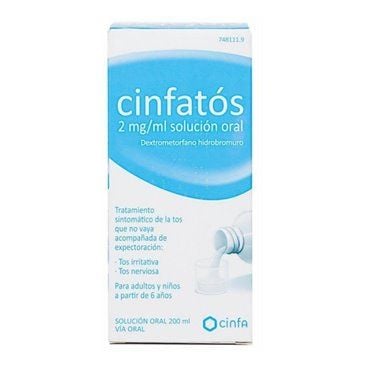Cinfatos 2 Mg/Ml Oral Solution 200 Ml (Pet)
Cinfatos Syrup is an effective antitussive for relieving dry cough. Its active ingredient, Dextromethorphan Hydrobromide, reduces the cough reflex, providing fast and long-lasting relief. Suitable for adults and children over 6 years old. Learn more by consulting the leaflet at Parafarmacia-Online.com.
Cinfatos Syrup is an effective antitussive for relieving dry cough. Its active ingredient, Dextromethorphan Hydrobromide, reduces the cough reflex, providing fast and long-lasting relief. Suitable for adults and children over 6 years old. Learn more by consulting the leaflet at Parafarmacia-Online.com.
Reduced price!
718655 718655 8470007186557
New product
More info
Cinfatos Syrup 200ml: Effective Relief for Dry Cough
dextromethorphan hydrobromide
What is Cinfatos Syrup and what is it used for?
Cinfatos Syrup is a medication formulated to relieve dry cough, also known as non-productive or irritating cough. Its active ingredient, Dextromethorphan Hydrobromide, works directly on the brain's cough center to reduce the urge to cough. This helps provide uninterrupted rest and effective recovery.
It is especially useful for treating cough caused by mild respiratory infections, allergies, or nervous conditions, offering a safe, fast-acting, and long-lasting solution without respiratory depression or narcotic effects.
How does Cinfatos Syrup work?
Dextromethorphan Hydrobromide, the active ingredient in Cinfatos, inhibits the production of neurotransmitters responsible for triggering the cough reflex. After oral administration, it is rapidly absorbed, with effects starting within 15-30 minutes and lasting up to 6 hours.
Metabolized by liver enzymes CYP2D6 and CYP3A4, it is eliminated primarily through urine. This ensures effective relief while maintaining safety for most patients.
Who can use Cinfatos Syrup?
Cinfatos is indicated for adults, adolescents, and children over 6 years old to treat dry cough or irritating coughs caused by:
Mild respiratory infections.
Allergies or irritants.
Nervous or psychogenic cough.
It is not suitable for productive coughs or conditions like asthma or chronic obstructive pulmonary disease (COPD).
How to use Cinfatos Syrup?
Dosage recommendations:
Adults and children over 12 years: Take 5-10 ml every 4 hours or 15 ml every 6-8 hours, not exceeding 60 ml daily.
Children 6-11 years: Take 2.5-5 ml every 4 hours or 7.5 ml every 6-8 hours, not exceeding 30 ml daily.
Children under 6 years: Not recommended.
Always use the provided measuring cup to ensure accurate dosage. Avoid extending the treatment beyond 7 days without medical advice.
Cautions and contraindications
Do not use Cinfatos Syrup if:
You are allergic to Dextromethorphan Hydrobromide or other ingredients.
You have a productive cough or severe respiratory conditions like asthma or COPD.
You are taking antidepressants such as MAO inhibitors or SSRIs.
Avoid using Cinfatos during pregnancy or breastfeeding without medical supervision.
Customer opinions about Cinfatos Syrup
Users highlight the quick and effective relief provided by Cinfatos Syrup for nighttime cough episodes. Its fast action and minimal side effects make it a popular choice for managing dry cough.
Where to buy Cinfatos Syrup and price information
Purchase Cinfatos Syrup securely at Parafarmacia-Online.com, where you’ll find:
- Competitive prices.
- Genuine products with quality assurance.
- Fast and secure delivery.



